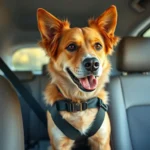
Introduction
Have you ever noticed your dog walking in circles before lying down? This peculiar behavior is a common sight among our furry companions, leaving many pet owners puzzled and curious. Why do dogs walk in circles before lying down? This seemingly simple act can be rooted in instinctual behaviors passed down from their wild ancestors, and understanding it can deepen the bond between you and your pet.
Understanding canine behaviors is crucial for pet owners. Not only does it provide insights into their needs and emotions, but it also helps us enhance our relationships with our dogs. By interpreting behaviors like circling, we can ensure our pets feel secure and comfortable in their environment.
The Origins of Circular Walking
Ancestral Instincts
To comprehend why dogs walk in circles before lying down, we must first consider their evolutionary background. Dogs are descendants of wolves, and many of their behaviors are inherited from these wild ancestors. In the wild, circling before lying down served several purposes. For one, it helped wolves create a comfortable sleeping area by flattening grass or leaves, clearing away debris, and providing a safer spot to rest.
This behavior also allowed them to check their surroundings for potential threats, ensuring they were in a safe environment before settling down. Thus, circling can be seen as a survival instinct, rooted deeply in their lineage.
Natural Instincts vs. Domestic Behavior
While our domestic dogs may not face the same dangers as their wild ancestors, some of these instinctual behaviors still prevail. In a domestic setting, the act of walking in circles before lying down may manifest differently. Although dogs have cozy beds and safe living spaces, the instinct to prepare a resting area remains.
This connection to their evolutionary past highlights the importance of understanding these behaviors. By recognizing that circling before lying down is part of their instinctual repertoire, we can appreciate their need for comfort and security.
Common Reasons for Circling Behavior
Comfort and Safety
One of the primary reasons why dogs walk in circles before lying down is to prepare their sleeping area. Just as wolves would flatten grass or leaves, your dog may circle around on their bed or the floor to create a comfortable spot. This behavior can help them shift bedding materials, ensuring a cozy and inviting place to rest.
Moreover, this circling can provide a sense of security. Dogs are creatures of habit, and establishing a routine helps them feel safe in their environment. When they take the time to circle before lying down, they are instinctively ensuring that their chosen resting area is free from potential threats and distractions, akin to their wild ancestors.
Temperature Regulation
Another reason for this behavior is temperature regulation. Dogs, like humans, seek the most comfortable resting conditions. By circling, they can find a position or spot that is either warmer or cooler, depending on their needs.
In colder climates, a dog might circle to find a warmer spot, tucking themselves into the most comfortable position possible. Conversely, in warmer weather, they may seek out cooler surfaces to avoid overheating. This instinctual behavior helps dogs maintain their body temperature, thus contributing to their overall comfort and well-being.
Anxiety and Stress Relief
For some dogs, circling can also be a response to anxiety or stress. Just as humans may engage in repetitive behaviors to soothe themselves, dogs may circle as a form of self-soothing. This behavior can be particularly pronounced in anxious dogs or those who may feel insecure in their environment.
Nervous circling can manifest in various ways, from spinning in tight circles to walking in broader arcs before settling down. Recognizing this behavior as a coping mechanism is essential for dog owners, as it signals the need for additional support and understanding.
Behavioral Variations Among Different Breeds
Breed-Specific Behaviors
Interestingly, not all dogs exhibit the same degree of circling behavior. Certain breeds are more prone to this behavior than others, often due to their historical roles and instincts. For instance, herding breeds like Border Collies or Australian Shepherds may display more pronounced circling due to their innate instincts to herd and control their environment.
On the other hand, breeds that were not traditionally working dogs might exhibit this behavior less frequently. Recognizing these breed-specific tendencies can help you better understand your dog’s behavior and tailor your care accordingly.
Age and Health Factors
As dogs age, their behavior can change, and circling may become more frequent or pronounced. Cognitive decline, arthritis, and other health issues can affect how a dog circles before lying down. For instance, an older dog with joint pain may take longer to find a comfortable position, leading to more pronounced circling.
It’s crucial for dog owners to monitor any changes in circling habits. If your dog suddenly starts circling excessively or seems distressed, it may be a sign of an underlying health issue that requires attention.
When to Be Concerned
Signs That Circling is Abnormal
While circling is a natural behavior for dogs, there are instances when it can become excessive or abnormal. If your dog is circling incessantly, appears disoriented, or struggles to settle down, these could be signs of a more serious issue.
Some potential warning signs to watch for include:
– Frequent or prolonged circling: If your dog circles for extended periods without settling down.
– Disorientation: Signs of confusion or lack of spatial awareness while circling.
– Accompanying symptoms: If circling is coupled with other concerning behaviors, such as loss of appetite, lethargy, or unusual vocalizations.
When to Consult a Veterinarian
If you observe any of the above warning signs, it may be time to consult a veterinarian. They can help determine if there are underlying medical concerns contributing to your dog’s circling behavior. Early intervention can lead to better outcomes, particularly if there are health issues like cognitive dysfunction or neurological disorders.
As a responsible pet owner, staying attuned to your dog’s behaviors and seeking professional advice when necessary is essential for their well-being.
Tips for Dog Owners
Creating a Comfortable Sleeping Environment
To support your dog’s natural behaviors, it’s important to provide a comfortable sleeping area. Here are some practical tips for creating an inviting space:
- Choose the right bedding: Invest in a good-quality dog bed that offers support and comfort. Orthopedic beds can be beneficial for older dogs or those with joint issues.
- Keep the area clean: Regularly wash bedding and ensure the resting area is free from debris or distractions.
- Provide a safe space: Ensure your dog’s sleeping area is in a quiet part of the house, away from loud noises or disturbances.
Managing Anxiety in Dogs
If your dog exhibits circling behavior due to anxiety, there are several strategies you can implement to help them feel more secure:
- Establish a routine: Dogs thrive on consistency. A regular schedule for meals, walks, and playtime can help reduce anxiety.
- Create a calm environment: Minimize loud noises and stressful situations. Consider using calming music or pheromone diffusers to promote relaxation.
- Provide enrichment: Engage your dog in mental stimulation activities, such as puzzle toys or training exercises, to keep them occupied and reduce stress.
Conclusion
In summary, why do dogs walk in circles before lying down? This behavior can be traced back to ancestral instincts, serving multiple purposes, including comfort, safety, and temperature regulation. While it is a common and natural behavior, pet owners should remain vigilant for any signs of abnormalities that may indicate underlying health concerns.
By understanding the reasons behind this behavior, you can enhance your relationship with your dog and ensure their well-being. Observing your dog’s unique behaviors can be a rewarding experience, allowing you to appreciate the nuances of their instincts and needs.
As you delve deeper into understanding your canine companion, consider exploring further resources on dog behavior and care. Your journey of discovery will undoubtedly strengthen the bond you share with your furry friend, making both of your lives richer and more fulfilling.









